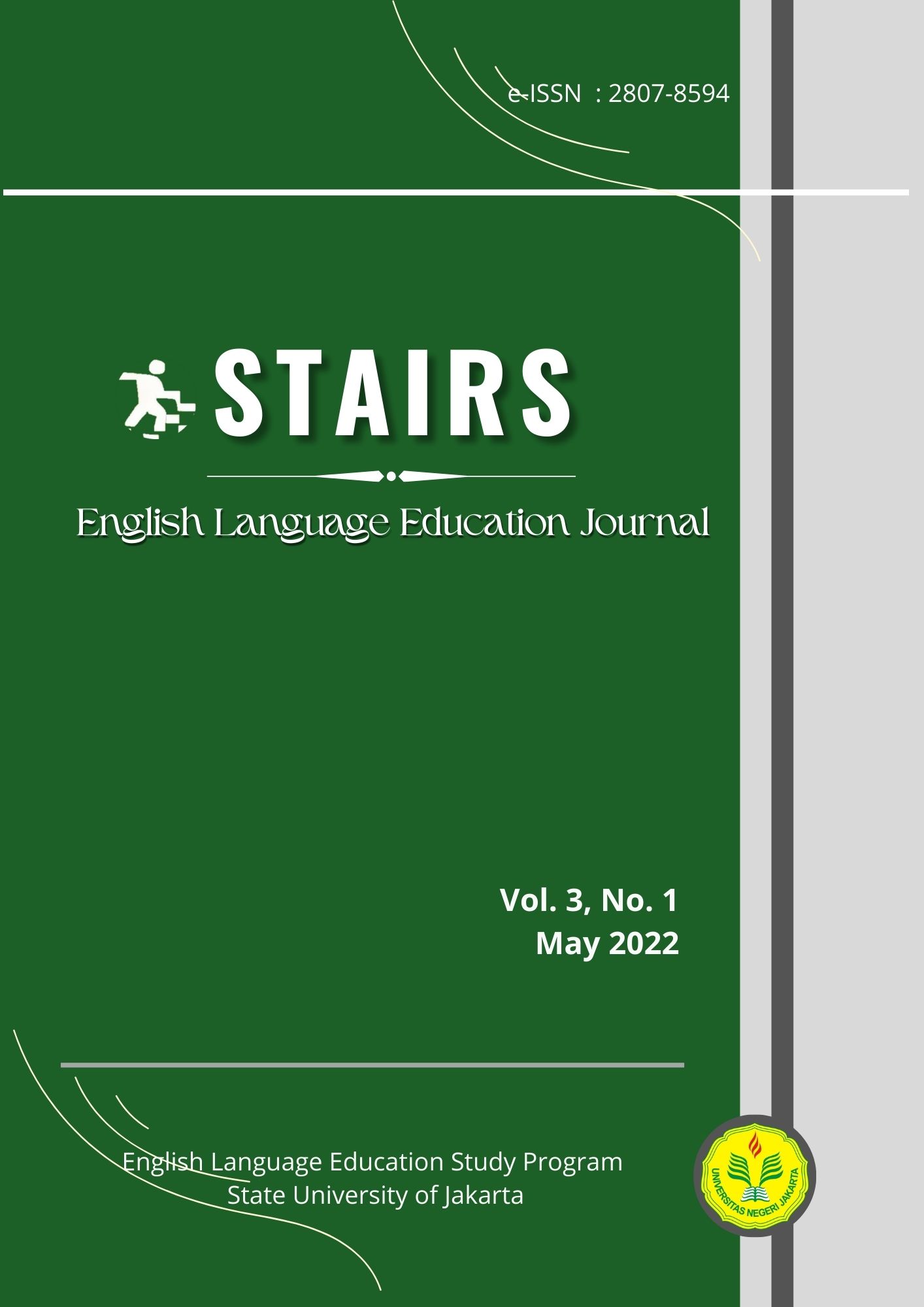Alignment of Assessment Tasks with the Intended Learning Outcomes in “EPP” and “EMS” courses of ELESP UNJ: A Content Analysis
DOI:
https://doi.org/10.21009/stairs.3.1.4Keywords:
Alignment, Learning Outcomes, Assessment TaskAbstract
This study aims at investigating the extent to which assessment tasks (ATs) and intended learning outcomes (ILOs) in Phonetics & Phonology (EPP) and English Morphology & Syntax (EMS) courses of ELESP are well aligned, and how their alignment with the knowledge (KD) and cognitive process dimension (CPD) is. Deductive qualitative content analysis techniques were implemented on the RPS document and assessment tools. It was found that 83% of the ATs in the EPP course are well-aligned with the ILOs. They support the students’ ability to Remember (8,82%), Understand (20,59%), and Apply (41,18%) the Conceptual (82,35%) and Procedural (17,65%) knowledge, while Analyze and Evaluate cover 2,94% and 26,47% respectively. However, the ATs tested students’ ability to Understand (25%) and Apply (75%) Conceptual (95%), and Metacognitive (5%) knowledge resulting in a misaligned teaching and learning exercise. In the EMS course, three out of six items (50%) of ATs are partially aligned, while only one AT (17%) is well-aligned with the ILOs. The ILOs support the students’ ability to Understand (50%) Conceptual (66,67%) and Metacognitive (33,33%) knowledge while the Analysis covers 50%. However, the ATs tested students’ ability to Understand (66,67%) and Apply (33,33%) Conceptual (100%) knowledge was misaligned.
References
Anderson, L. W. (2005). Objectives, Evaluation, and the Improvement of Education. Studies in Educational Evaluation, 31(2-3), 102-113.
Anderson, L. W., & Krathwohl, D. R. (Eds.). (2001). A Taxonomy for Learning, Teaching, and Assessing: A revision of Bloom's Taxonomy of Educational Objectives. New York: Allyn & Bacon.
Banta, T. W., & Palomba, C. A. (2015). Assessment Essentials: Planning, Implementing, and Improving Assessment in Higher Education. San Fransisco, CA: John Wiley & Sons.
Biggs, J. (1996). Enhancing Teaching through Constructive Alignment. Higher Education, 32, 347–364.
Biggs, J. (2003). Aligning Teaching and Assessment to Curriculum Objectives. Imaginative Curriculum Project. USA: LTSN Generic Centre.
Biggs, J. (2014). Constructive Alignment in University Teaching. (P. Kandlbinder, Penyunt.) HERDSA Review of Higher Education, 1, 5-22.
Bloom, B. E. (1956). Taxonomy of Educational Objectives: The Classification of Educational Goals. Handbook I: Cognitive Domain. New York, Toronto: Longmans, Green.
Brown, H. D. (2004). Language Assessment: Principles and Classroom Practices. New York: Pearson Education.
Christison, M., & Murray, D. E. (2014). What English Language Teachers Need to Know (Vol. III). New York, NY: Taylor & Francis.
Earl, M., & Katz, M. (2006). Rethinking Classroom Assessment with Purpose in Mind; Assessment for Learning, Assessment as Learning, and Assessment of Learning. Monitoba Education.
Elo, S., & Kynga, H. (2008). The Qualitative Content Analysis Process. Advanced Nursing, 62(1), 107–115.
FitzPatrick, B., Hawboldt, J., Doyle, D., & Genge, T. (2015). Alignment of Learning Objectives and Assessments in Therapeutics Courses to Foster Higher-Order Thinking. American Journal of Pharmaceutical Education, 79(1), 1-8.
Gavora, P. (2015). The State-of-the-Art of Content Analysis. Education Sciences, 1, 6-18.
Gerritsen-van Leeuwenkamp, K. J., Brinke, D. J.-t., & Kester, L. (2017). Assessment Quality in Tertiary Education: An Integrative Literature Review. Studies in Educational Evaluation, 55, 94-116.
Graves, K. (2014). Syllabus and Curriculum Design for Second Language Teaching. In M. Celce-Murcia, D. M. Brinton, & M. A. Snow (Eds.), Teaching English as a Second or Foreign Language (4th ed., pp. 46-62). Boston, MA: Cengage Learning.
Hsieh, H.-F., & Shannon, S. E. (2005). Three Approaches to Qualitative Content Analysis. Qualitative Health Research, 15(9), 1277-1288.
Jideani, V. A., & Jideani, I. A. (2012). Alignment of Assessment Objectives with Instructional Objectives Using Revised Bloom's Taxonomy — The Case for Food Science and Technology Education. Journal of Food Science Education, 11(3), 34-42.
Kabouha, R., & Elyas, T. (2015). Aligning Teaching and Assessment to Course Objectives: The Case of Preparatory Year English Program at King Abdulaziz University. International Journal of Applied Linguistics & English Literature, 4 (5), 82-91.
Kibble, J. D. (2017). Best Practices in Summative Assessment. Adv Physiol, 110 -119.
Krathwohl, D. R. (2002). A Revision of Bloom's Taxonomy: An Overview. Theory into Practice, 41(4), 212-218.
Mahboob, A. (2008). Assessment in Higher Education. A Case Study from Australia. Karachi: University of Karachi Press.
Marzano, R. J., Norford, J. S., Pickering, D. J., & Paynter, D. E. (2001). Handbook for Classroom Instruction that Works. Alexandria, VA: Association for Supervision and Curriculum Development.
Mayring, P. (2014). Qualitative Content Analysis. Theoretical Foundation, Basic Procedures, and Software Solutions. Klagenfurt, Austria: Philipp Mayring.
McMahon, T. (2006). Teaching for More Effective Learning: Seven Maxims for Practice. Radiography, 12, 34–44.
McMillan, J. H. (2018). Classroom Assessment Principles and Practice that Enhance Student Learning and Motivation (7th ed.). New York, NY: Pearson.
Nation, I. P., & Macalister, J. (2010). Macalister, John, and IS Paul Nation. Language Curriculum Design. Routledge, 2019. New York, NY: Routledge.
OECD/ADB. (2015). Education in Indonesia: Rising to the Challenge. Paris: OECD Publishing.
Race, P., Brown, S., & Smith, B. (2005). 500 Tips on Assessment (2nd ed.). New York, NY: RoutledgeFalmer.
Van der Vleuten, C., Sluijsmans, D., & Joost. (2017). Competence Assessment as Learner Support in Education. In I. M. Mulder (Ed.). Competence-based Vocational and Professional Education. Bridging the Worlds of Work and Education. Cham, Switzerland: Springer International Publishing Switzerland.
Wiggins, G. P., & McTighe, J. (2005). Understanding by Design (2nd ed.). Alexandria, VA: Association for Supervision and Curriculum Development (ASCD).



